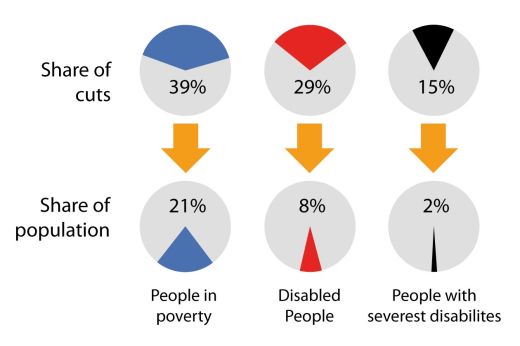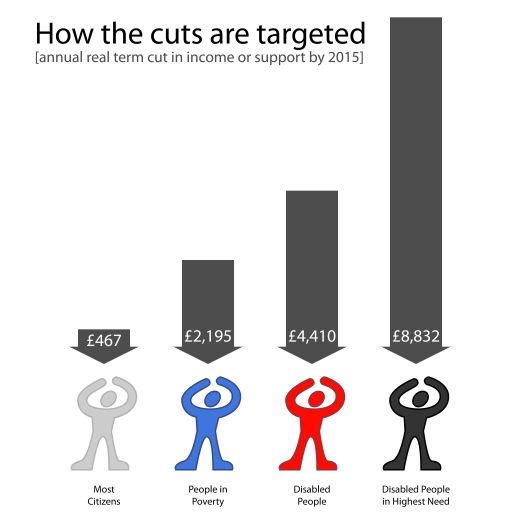This briefing provides a summary of the findings of the report A Fair Society? and some important facts and figures.
Author: Dr Simon Duffy
The UK government is making big cuts in public expenditure in order to try and solve a financial crisis that was primarily triggered by excessive house price inflation, private borrowing and over-lending by the banks. However, most people think that everything is being cut and that the cuts being made are probably fair. The latest report from The Centre for Welfare Reform - A Fair Society? - shows that this is not true.
Not everything is being cut.
In fact over 50% of cuts fall in just two areas which together make up only 25% of government spending:
The cuts are not fair.
They target the very groups that a decent society would protect:
These facts are represented in the following info-graphic:

 The unfairness of this policy is seen even more clearly when we look at the difference between the burden of cuts that falls on most citizens and the burdens that fall on minority groups. By 2015 the annual average loss in income or services will be:
These facts are represented in the following info-graphic:

This also means that if we compare the relative targeting of the cuts on different groups then:
These facts are represented in the following info-graphic:

If regressive tax increases were also included in this analysis the picture would be even worse.
This is a conservative analysis, based upon facts taken from the government’s own reports and from the reports of reputable national bodies like CIPFA and ADASS.
Cuts to social care are already in underway - over £4 billion has already been cut from the social care budget reducing care and support to disabled children, adults and frail older people.
Cuts to benefits are being disguised within ‘reforms’ that mask reductions in the value, type and scope of benefits.
The UK is the third most unequal developed country in the world and most disabled people live in poverty. The current policy is guaranteed to increase inequality and to make extreme poverty even worse.
All of this may seem surprising given the UK government’s claim that the cuts would be “fair” and that they have even provided “extra money” for social care. However it seems that many of the government’s claims are either very misleading or utterly false.
Many people do not know the real facts about the current welfare system:
The report argues that the main reason for the unfairness of the cuts is that the current democratic and welfare system has a built-in bias towards protecting some services and for cutting others. The public have been persuaded that the NHS, pensions and education are universal services that benefit everybody; but they see benefits and social care as being for ‘other people’.
This bias is highly dangerous, especially when politicians pander to it, and use the rhetoric of ‘shirkers’, ‘scroungers’ or ‘cheats’ to appeal to the prejudices of swing voters. A new level of honesty and self-discipline is required within our political elites.
Not only is this policy dangerously unfair it will be ineffective. Increased inequality and reduced social care will increase social crises, crime, institutionalisation and will increase the inefficiency of other public services, like the NHS. Benefits and social care are relatively efficient and effective at reducing need and strengthening communities.
The current economic crisis was created by unsustainable house price inflation which was certainly not caused by people in poverty or by disabled people. Nor did they benefit from this inflation in asset values. However they are now being made to foot the bill for the mistakes of others. None of this is necessary. Even if one were to accept the need for public expenditure cuts then effective salary control would have saved jobs and reduced inequality.
The Campaign for a Fair Society demands that MPs of all political parties call for:
All the facts, figures and analysis described above can be found in the latest report by The Centre for Welfare Reform titled:
A Fair Society? How the cuts target disabled people
The statistics are taken from government sources. Most refer to the real term impact of funding changes by 2015, primarily as set out in the 2010 CSR. However many later changes and amendments have been included, particularly the increased cut to benefits which has increased from an original cut of £10 billion in 2010, to a planned cut of £22 billion.
The report was produced, pro bono, for the Campaign for a Fair Society, an alliance of over 300 charities who are advocating an end to unfair cuts and the radical reform of the welfare state:
www.campaignforafairsociety.com
The author of the report is Dr Simon Duffy, winner of the RSA Prince Albert Medal and the Social Policy Association award for outstanding contribution to social policy: http://about.me/simonduffy
The publisher is The Centre for Welfare Reform.
Briefing on How Cuts Are Targeted © Simon Duffy 2013.
All Rights Reserved. No part of this paper may be reproduced in any form without permission from the publisher except for the quotation of brief passages in reviews.
Cumulative Impact, social care, tax and benefits, Article